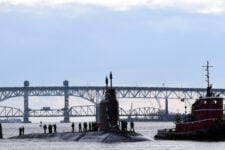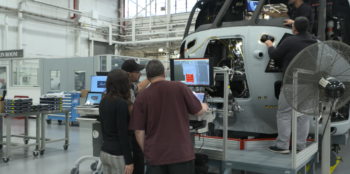
The Pentagon Headquarters of the United States Department of Defense (Getty images)
During the height of the Covid-19 pandemic, the world learned of a little-known Pentagon tool known as the Defense Production Act. Four years late, the DPA has become a go-to for goosing the industrial base as needed. In this new op-ed, former Pentagon official Jeb Nadaner writes that the 2025 deadline to reauthorize the DPA should serve as a chance to reinvent it for current needs.
Nearly four years ago, while serving as the senior Pentagon official responsible for the defense industrial base, I learned of an issue affecting one of the nation’s largest weapons programs. Part of the pulley system moving combat aircraft down the assembly line was giving out. Factory parts need replacement from time to time, so this was not necessarily unusual — until I learned the pulley dated back to World War II.
This was an eye-opening example of a more pervasive problem: The US military, for all its prowess, relies on an aging, undersized, and fragile industrial apparatus to produce and sustain vital weapons systems. With the return of industrial scale warfare in Europe, Iran’s offensives across the Middle East, and, most of all, the rise of a technically advanced, aggressive China, the threats we face require significantly larger US output of defense supplies — ships, aircraft, new autonomous vehicles, and most of all, long-range munitions. And the US is not positioned to meet that demand.
This is the elephant in the (committee) room as Congress works on reauthorizing the Defense Production Act (DPA), which allows the president to respond quickly to alleviate shortages of materials and goods essential to national security. The challenge facing lawmakers now is two-fold. At the micro-level the DPA requires procedural and policy changes to fulfill better the relatively limited scope and scale of its existing mission. At the macro-level, the US defense industrial base — companies, assembly lines, plus access to needed materials and skilled workers — has so hollowed out since the end of the Cold War that one-off rifle shot investments in niche capabilities, however worthy, are woefully inadequate.
A re-authorized DPA also facilitate the expansion and strengthening of the defense-related production infrastructure, militarily unique (e.g., field and air defense artillery) and dual-purpose commercial (from software to shipyards). It should include provisions to help speed up the process. And above all, it has to be focused on how to bring 21st century technology into the department at a faster rate.
The DPA has (generally) served the nation well. First passed in the early months of the Korean War, with multiple revisions since, this authority was used by President George W. Bush after Hurricane Katrina to fix railway tracks to move supplies across Mississippi; by Secretary of Defense Robert Gates to get the reinforced steel for armored vehicles that could withstand improvised bombs in Iraq; and by President Donald Trump to push auto plants to manufacture ventilators in the early months of the COVID-19 epidemic.
In support of specific national defense industrial priorities, the Pentagon, over the past few months, has announced DPA awards for nickel and cobalt, graphite, titanium powder, military-grade chemicals, microelectronics packaging, and circuit board assemblies for hypersonic weapons. Last year, grants amounted to roughly $750 million — much higher than the post-Cold War norm but down from the $1 billion-plus allocated in 2022 after Russia invaded Ukraine.
That’s good, yet it’s a drop in the bucket compared to what is needed — at least $100 billion over the next five years — to modernize, diversify, and expand factory lines, shipyards, depots, mines, and vocational training at a scale required to deter China in the Indo-Pacific and beyond.
Consider that in Indo-Pacific wargames, the US typically runs out of long-range air-launched munitions in days. Correspondingly, the Chinese Navy, now the world’s largest at 340 combat ships, is projected to grow to about 440 ships by 2030, not including dozens more patrol boats that can carry anti-ship missiles. Under current budget projections, the US Navy’s battle fleet will stay stuck under 300 during this period. The examples could go on and on.
A more industrial-scale DPA can help close the investment deficit. To get there, this next reauthorization should drive the related imperatives of capacity and speed.
For starters, expanding the defense industrial base — physical plant and human capital — will require attracting investment beyond the level of financial support that can be provided directly (or intelligently) by the government. The DPA has long allowed loan guarantees in addition to grants, but the DoD has shied away from issuing the former. Loan guarantees can be the cheapest yet most effective way to attract private sector investments using basis points to measure and mitigate credit risk. This approach retains private sector entrepreneurial initiative and decision-making rather than have the government pick winners.
The DPA should reflect the 21st-century reality that the distinction between commercial and defense has blurred, if not erased, in many vital areas. China recognized this long ago with its generously funded approach to civil-military fusion. The grants, credit, and loan guarantees program could help break up the oligopoly of traditional aerospace and defense contractors by facilitating the entry of commercial technology providers who have been so effective in space launch, unmanned/autonomous systems, and software.
Increasing the speed of DPA project execution is vital, too. Today, DPA undertakings are hamstrung by the same regulations that delay nearly every other industrial and building project of consequence in our country. In recent years, FAST 41 authorities have helped streamline the permitting processes for some infrastructure projects. The next iteration of DPA should also automatically apply FAST 41 provisions to DPA awards.
To generate the additional needed technically skilled workers, private companies should be permitted to use DPA support to recruit and train Americans in the advanced touch labor trades necessary for military hardware production: machinists, welders, electricians, chemical technicians, assemblers, pipefitters, and more.
A higher volume of projects will require the Department’s systems and processes for handling DPA applications and funding to enter the digital era. A significant expertise upgrade is needed too at DoD to process an expanded range of DPA applications and activities. The next authorization should require and fund the hiring of engineering, technological, and supply chain experts — preferably directly from the commercial sector and unbound by civil service regulations — in energetics; critical mineral processing, metallurgy, and materials; electronics; castings and forgings; machine tools and advanced manufacturing; weapons computing; and shipbuilding and maintenance. No one wants to swell the Pentagon headcount further, but a dozen of the right people in this area — compared to the hundreds and thousands in other DoD staff functions — can have a measurably strategic impact.
And in what will likely be the most controversial point: the new authorization should have guardrails to make sure the DPA is used for defense, and doesn’t become just a catchall tool for an administration’s priorities. Consider The Atlantic’s June 2022 headline: “Biden’s Climate Goals Rest on the Defense Production Act.” Depending on one’s view, heat pumps, solar panels, windmills, hydrogen cells, and other carbon-reducing systems may or may not merit federal support — but that is not what the DPA is for. Let appropriations for these happen in clearly delineated climate or green energy bills, for which Congress holds up or down votes.
These added private sector incentives and outlays — processed and dispensed more rapidly — may enrich certain entrepreneurs and companies. There will inevitably be a few flops — always a risk whether it comes to private venture capital or government industrial policy in an essential area. The supreme goal here is not efficiency or fairness, but more production capacity to accelerate US defense acquisition and grow US military effectiveness.
Ultimately, America has three decades of chronic underinvestment and industrial consolidation to overcome, and the hour is late (In this respect, the name “Defense Industrialization and Production Act” may better reflect what Congress is trying to achieve). A genuinely 21st-century DPA will enable the United States to continue meeting short-fuse military orders while thickening the industrial base to ensure that our weapons stocks are full and assembly lines are rolling at the time of reckoning.
Jeffrey “Jeb” Nadaner is Senior Vice President at Govini and a former Deputy Assistant Secretary of Defense for Industrial Policy.
HASC pushes for reciprocity guidance for cloud computing in draft NDAA language
The legislation proposes that if one office in the department officially deems a “cloud-based platform, service, or application” is sufficiently cybersecure to use, then all parts of DoD can accept this ATO.


























